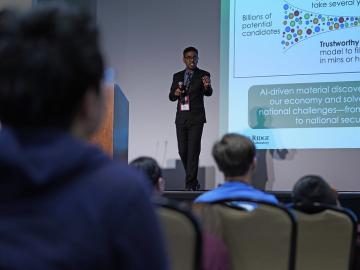
Filter News
Area of Research
- Advanced Manufacturing (4)
- Biological Systems (1)
- Biology and Environment (46)
- Clean Energy (45)
- Computational Biology (2)
- Computational Engineering (3)
- Computer Science (6)
- Electricity and Smart Grid (1)
- Functional Materials for Energy (1)
- Fusion and Fission (5)
- Isotopes (6)
- Materials (31)
- Materials for Computing (5)
- Mathematics (1)
- National Security (18)
- Neutron Science (20)
- Nuclear Science and Technology (2)
- Renewable Energy (1)
- Sensors and Controls (1)
- Supercomputing (67)
News Topics
- (-) Artificial Intelligence (97)
- (-) Biomedical (60)
- (-) Clean Water (31)
- (-) Composites (29)
- (-) Emergency (2)
- (-) Hydropower (11)
- (-) Quantum Computing (37)
- (-) Security (25)
- 3-D Printing/Advanced Manufacturing (125)
- Advanced Reactors (34)
- Big Data (60)
- Bioenergy (92)
- Biology (100)
- Biotechnology (23)
- Buildings (61)
- Chemical Sciences (70)
- Climate Change (104)
- Computer Science (195)
- Coronavirus (46)
- Critical Materials (29)
- Cybersecurity (35)
- Decarbonization (82)
- Education (4)
- Element Discovery (1)
- Energy Storage (112)
- Environment (198)
- Exascale Computing (40)
- Fossil Energy (6)
- Frontier (44)
- Fusion (57)
- Grid (66)
- High-Performance Computing (90)
- Irradiation (3)
- Isotopes (55)
- ITER (7)
- Machine Learning (49)
- Materials (145)
- Materials Science (145)
- Mathematics (9)
- Mercury (12)
- Microelectronics (4)
- Microscopy (51)
- Molten Salt (8)
- Nanotechnology (60)
- National Security (71)
- Net Zero (14)
- Neutron Science (134)
- Nuclear Energy (110)
- Partnerships (49)
- Physics (63)
- Polymers (33)
- Quantum Science (71)
- Renewable Energy (2)
- Simulation (49)
- Software (1)
- Space Exploration (25)
- Statistics (3)
- Summit (59)
- Sustainable Energy (130)
- Transformational Challenge Reactor (7)
- Transportation (97)
Media Contacts

Brian Sanders is focused on impactful, multidisciplinary science at Oak Ridge National Laboratory, developing solutions for everything from improved imaging of plant-microbe interactions that influence ecosystem health to advancing new treatments for cancer and viral infections.

Brittany Rodriguez never imagined she would pursue a science career at a Department of Energy national laboratory. However, after some encouraging words from her mother, input from key mentors at the University of Texas Rio Grande Valley, or UTRGV, and a lot of hard work, Rodriguez landed at DOE’s Manufacturing Demonstration Facility, or MDF, at Oak Ridge National Laboratory.
The contract will be awarded to develop the newest high-performance computing system at the Oak Ridge Leadership Computing Facility.

To better predict long-term flooding risk, scientists at the Department of Energy’s Oak Ridge National Laboratory developed a 3D modeling framework that captures the complex dynamics of water as it flows across the landscape. The framework seeks to provide valuable insights into which communities are most vulnerable as the climate changes, and was developed for a project that’s assessing climate risk and mitigation pathways for an urban area along the Southeast Texas coast.

Researchers conduct largest, most accurate molecular dynamics simulations to date of two million correlated electrons using Frontier, the world’s fastest supercomputer. The simulation, which exceed an exaflop using full double precision, is 1,000 times greater in size and speed than any quantum chemistry simulation of it's kind.

Researchers used quantum simulations to obtain new insights into the nature of neutrinos — the mysterious subatomic particles that abound throughout the universe — and their role in the deaths of massive stars.
Close on the heels of its fourth summer school, the Quantum Science Center, or QSC, hosted its second in-person all-hands meeting in early May. More than 150 scientists, engineers and support staff traveled from 17 institutions to review the QSC’s progress, examine existing priorities and brainstorm new short- and long-term research endeavors.

Researchers at ORNL and the University of Maine have designed and 3D-printed a single-piece, recyclable natural-material floor panel tested to be strong enough to replace construction materials like steel.

Prasanna Balaprakash, a national leader in artificial intelligence, or AI, spoke to some of the highest achieving students in the country at the National Science Bowl in Washington D.C.

Purdue University hosted more than 100 attendees at the fourth annual Quantum Science Center summer school. Students and early-career members of the QSC —headquartered at ORNL — participated in lectures, hands-on workshops, poster sessions and panel discussions alongside colleagues from other DOE National Quantum Information Science Research Centers.


